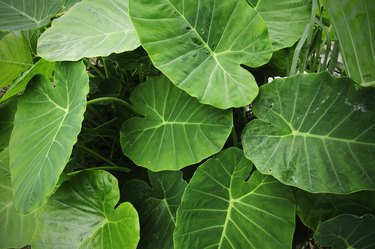
Elephant ear plants are large, tropical plants that thrive in the Southeastern United States. The leaves are heart-shaped and can reach up to 5 feet in length. They develop a thick, robust root system that you can cut away, and you can learn how to propagate elephant ears. However, you'll only be able to grow elephant ears if you know about ideal growing conditions and how to care for these beautiful, stately plants.
Splitting Joined Elephant Ear Bulbs
Video of the Day
Elephant ears are a type of perennial that grows from a bulb. Over time, that bulb develops a robust root system capable of supporting and watering the large leaves that a matured elephant ear plant will have. It's important to note that elephant ears are not true bulbs; they actually grow from corms or tubers, although they're often collectively called "bulbs." While there is only one plant species that's commonly called elephant ears, this name technically refers to three primary plant genera: Colocasia, Alocasia and Xanthosoma.
Video of the Day
To separate the root system of elephant ears, you'll want to begin by ensuring your plant is strong enough to withstand the process. The leaves should be healthy and green, and you should wait until the late spring or early summer to begin this entire process to ensure the plant can survive.
About a foot away from the base of the plant, you should dig a trench 6 inches deep in a circle around it. You'll use this trench to dig underneath the elephant ear tree. Using a shovel to leverage, you can dig underneath the root ball and lift it. The root ball will look like a giant tangle of branches and bulbs. You'll need to work through that to propagate.
How to Propagate Elephant Ears
Use your fingers to separate the thin roots and then spray the root ball with your garden hose to help clean off excess dirt and expose the main center bulb. This center root is the bulb you originally planted that supports the tree's main branches. Around the center bulb, you should see many smaller bulbs growing among the complex root systems. These are the elephant ear bulbs that you can cut away to propagate.
How many elephant ears come from one bulb? Each bulb can eventually grow its own dense root system so that many elephant ear plants can come from each bulb. Begin by testing these smaller bulbs with your hands. Some may break away easily, and these are the best ones to plant. Otherwise, you may need to use a short, sharp knife (like a paring knife) to cut them away.
Once you have your new bulbs to plant, replace the main bulb and the rest of the roots in the ground. Bury them again by replacing the dirt in the trench and water generously. Plant your extra bulbs in appropriate places and enjoy new plants within a few years.
Caring for Elephant Ear Plants
For your elephant ears to thrive, they need proper care, beginning with where you plant the bulbs. In terms of climate, these are naturally tropical plants, so they prefer hot, humid conditions. In the United States, they thrive in the Southeast. They don't need a lot of sunshine; you should plant them in partial sun or mostly shaded locations.
Elephant ears don't just like humidity; they also like wet conditions. Their roots don't get root rot, and it's good for them to sit in wet soil. They can grow in several inches of water in marshy or swampy conditions. They're perfect if you have standing water in your yard that you want to try to absorb. Feed the soil regularly with a nitrogen-rich fertilizer.
Elephant ear plants don't need a lot of pruning, but you should remove dead and dying leaves to make room for new growth. Cut them near the stem and compost or discard them.